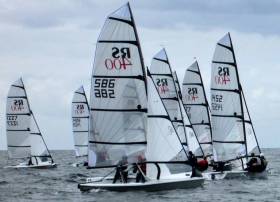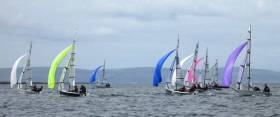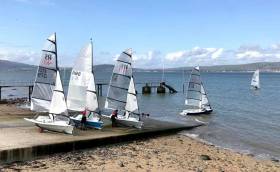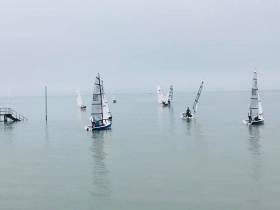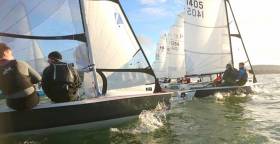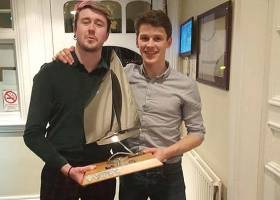Displaying items by tag: RS400
As the RS400 fleet comes together on Belfast Lough this weekend, the newly crowned RS200 champion Chris Bateman reviews the recent RS gathering at Galway Bay Sailing Club that provided a weekend of racing in tight competition.
As Afloat previously reported here, several events were to be run over the three days. RS 400s and Fevas were competing in their Western championships, with the RS200 fleet competing in their National Championships. Two days of racing were scheduled for those entered in Westerns, three days were scheduled for those racing in the RS200 Nationals.
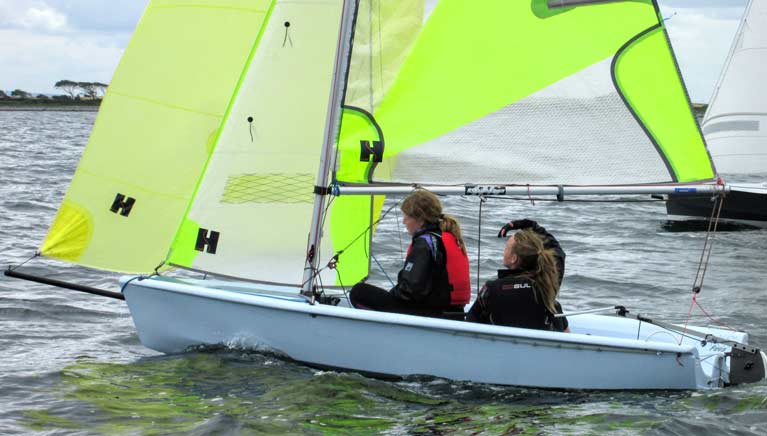 RS Fevas were competing for Western championships honours
RS Fevas were competing for Western championships honours
It was a grey start to day one of the RS 200 nationals. Cloud and light rain created an authentic scene for the west of Ireland. The sailors arrived early to rig their boats. With a short briefing at 10:30am, the competitors were ready to sail.
A twelve-knot breeze blew down the bay. With a long course set, racing was underway. Taking the win for race one was Conor and Jack Galligan from Greystones SC. Race two was won by Chris Bateman and Atlee Kohl (MBSC/RCYC). With the wind dying slowly, racing became tricky. Jocelyn Hill and Katie Kane from Co. Antrim SC showed good speed, winning the final race of the day. Conor and Jack Galligan sailed well, giving them an overnight lead after day one.
Another dull morning greeted the fleet for day two. The RS 200’s were joined by the 400’s and Fevas, who arrived early to make it in time for the 11 am start. Howling winds blew across the bay, with winds in excess of 25 knots. A one-hour postponement later, and racing was called off for the day.
Day three dawned with much more promising views. A steady 10-12 knot breeze had filled in overnight and racing was sure to go ahead. The competitors had a quick briefing and in no time were on the water. Four races were scheduled, and conditions were perfect.
The RS 400 fleet started first, with 11 boats lining up on the start. Barry McCartin and Andrew Penney (CSBC/RstGYC) took first place in race one of their westerns. The RS 200 fleet started second, and as points were tight the start line was a competitive place. Taking another win was the Galligans. In the Feva fleet, two boats joined the other RS sailors to race in their Westerns.
Race two saw Barry McCartin and Andrew Penney take first place. This was the second of four wins in total (a clean sweep). In the RS 200 fleet, Adam Power and Jack Young (Previous RS 200 nationals winners) took the win, having sailed exceptionally well around the course.
Race three and four were got underway quickly, to finish racing within the time limit. In the RS 400’s McCartin and Penney got two more wins. In the RS 200 fleet, Chris Bateman and Atlee Kohl also clinched two wins, in very tight racing.
The sailors returned to shore, tired but having had a solid day sailing. A few protests later, and prizegiving was underway. In the RS 400 fleet, Barry McCartin and Andrew Penney took first place, winning the Western championships. In second was Chris and Niall Eames (SLYC). In third place was Govan Berridge and David Coleman (Killaloe SC).
For the RS 200 Nationals, it had been tight racing with high competition. Winning the Championships was Chris Bateman crewed by Atlee Kohl (MBSC/RCYC). In second place (a point below) was Conor and Jack Galligan (Greystones SC). In third place was Frank O’Rourke and Emma Hynes (Greystones SC), having sailed fast, and holding a very consistent series.
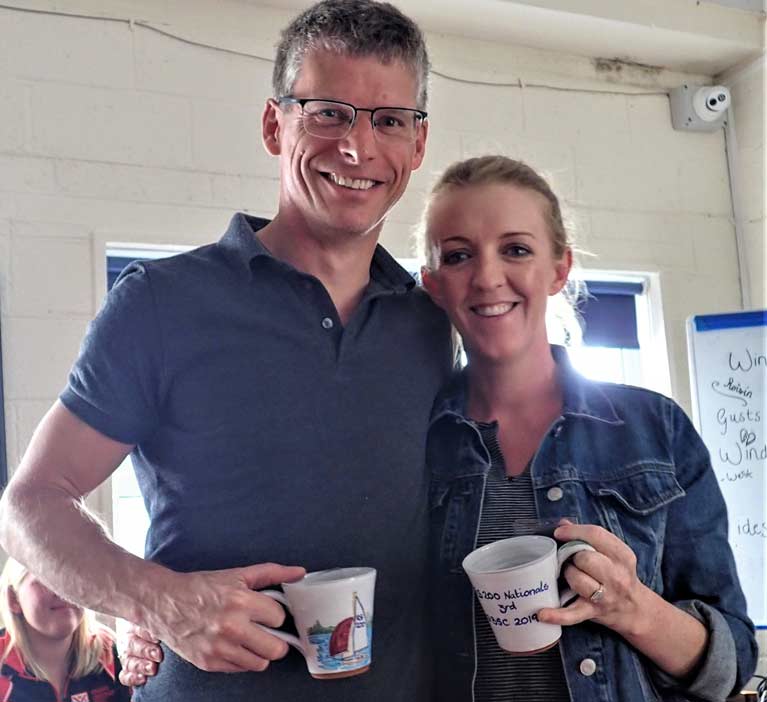 Frank O'Rourke and Emma Hynes, 3rd place RS 200 Nationals
Frank O'Rourke and Emma Hynes, 3rd place RS 200 Nationals
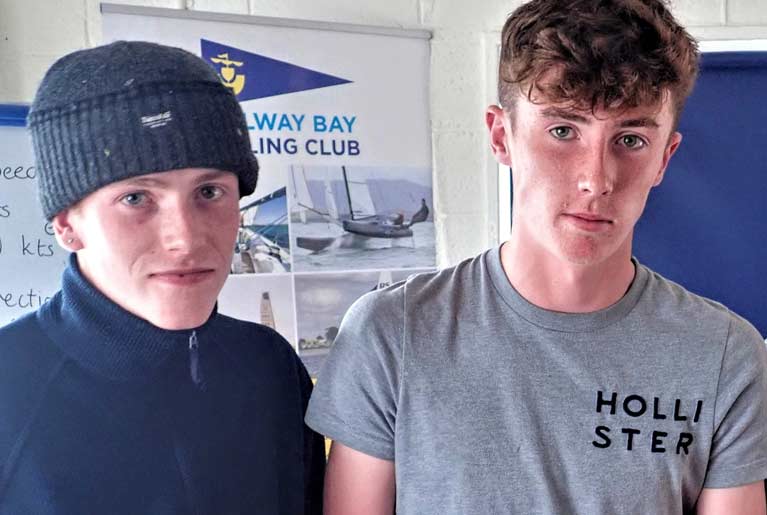 The Galligan's, 2nd RS 200 nationals
The Galligan's, 2nd RS 200 nationals
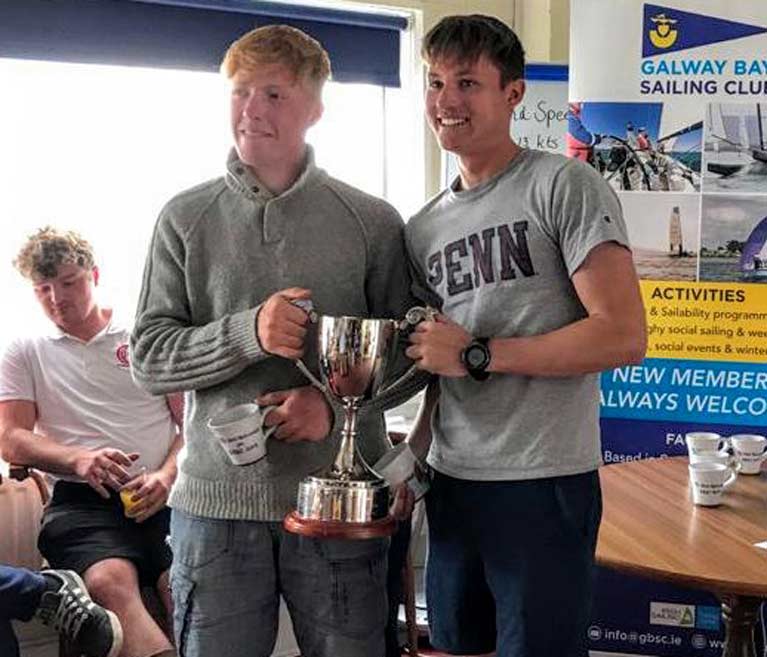 Chris Bateman crewed by Atlee Kohl, 1rst RS 200 nationals
Chris Bateman crewed by Atlee Kohl, 1rst RS 200 nationals
RS Classes Move From Galway Bay To RS400 Ireland & UK Nats on Belfast Lough & Dinghyfest
Ireland’s expanding RS Classes are in acceleration mode as they build towards the Irish & UK RS 400 Nats at Royal North of Ireland YC at Cultra on Belfast Lough from 25th to 29th August, and the all-classes RS Southerns within the Royal Cork Yacht Club Dinghyfest on the weekend of 14th to 15th September.
The west coast came into the developing programme over the extended weekend of August 9th to 11th, when Galway turned its attention from the horses of the annual Galway Races to the prospect of riding white horses on the seas off Galway Bay SC. But on the first day, the RS 200s were frustrated in some of their hopes, for the winds were easterly, and with the big breeze arriving over the land and showers passing through, the sea was flat but the wind was very variable in strength and direction.
The course was set up with a windward mark and a leeward gate. The strong and shifting winds gave the sailors plenty to think about, particularly on the downwind legs, with a variety of strategies being employed to maximise the effectiveness of the large asymmetric spinnakers.
Despite the challenges, the day saw four races successfully completed, with Conor and Jack Galligan from Greystones leading the field, having taken two of them. Friday evening saw the arrival of the RS400 and RS Feva fleets ahead of their Westerns, but there was disappointment on Saturday morning as high westerly winds whipped the sea into a frenzy of short, sharp breakers. It was white horses in profusion and then some. But after an inspection of the race area, Safety Officer Mox Henderson concluded that the sea state would make race management impractical, and racing had to be postponed for the day.
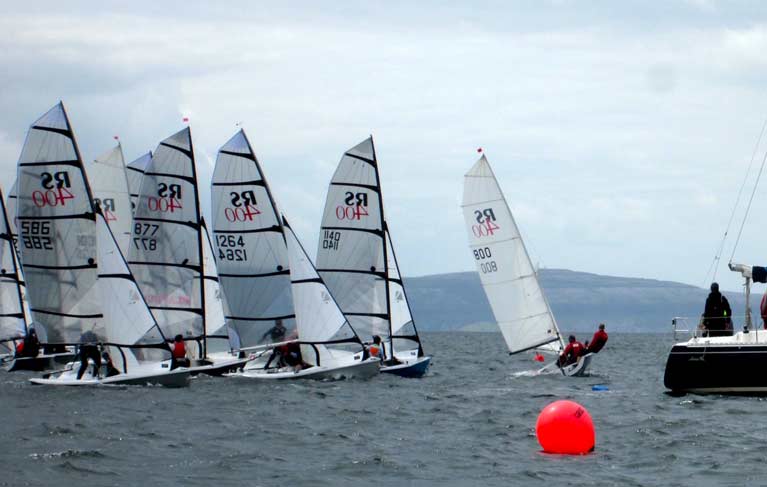 Keen to get going – the RS 400s had fewer days in Galway Bay, and were out to make the best of them
Keen to get going – the RS 400s had fewer days in Galway Bay, and were out to make the best of them
It was all change as brighter conditions dawned on Sunday. The wind came around to the North, the sea calmed and the force 3 - 4 winds allowed the boats to reach quickly to the course. Four races were completed by Race Officers David Vinnell and Aoife Lyons for all three fleets, with the shifting winds again rewarding an appreciation of micro-meteorology. In the 200 fleet, Chris Bateman and Atlee Kohl from Monkstown Bay made the most of the conditions to finish the overall series ahead of the Galligans. Another Greystones boat, with Frank O'Rourke and Emma Hynes aboard, came in third.
In the 400 fleet, first place went to Barry McCartin and Andrew Penney from Cushendall and the Royal St. George, who won all four races. Chris and Niall Eames from Strangford Lough managed to take second place by just one point from Govan Berridge and David Coleman from Killaloe. In the Feva fleet, GBSC's Robert Donelly and Aly O'Sullivan held out to take top spot ahead of Ella Lyons and Veronica O'Dowd.
And now, Belfast Lough and Cork Harbour beckon for a crescendo of RS dinghy sport.
 Chris Bateman & Atlee Kohl of Monkstown Bay SC, winners of the RS 200s at Galway, with Irish Sailing Board Member (West) Rory Carberry
Chris Bateman & Atlee Kohl of Monkstown Bay SC, winners of the RS 200s at Galway, with Irish Sailing Board Member (West) Rory Carberry
McCartin & Penny Win RS400 Inlands at Blessington
Over 20 RS400 made the trip for the past weekend’s Inland Championships hosted by Blessington Sailing Club. Nestled to the west of the Wicklow Mountains the sailing club boasts a sandy beach, plenty of room for onsite camping and with a big BBQ planned it provided the perfect getaway for the weekend.
Racing on a reservoir with light winds forecast, flat water and high land, this event was going to be a mental test for competitors in what is normally a fast, physical class and could see some interesting results.
Race one got underway and it soon became clear just how challenging the tactics would be, shifts in the wind could have you laying the windward mark from the start line or headers that almost tacked the boat before the helms even had a chance to react.
Leading the way to the first mark was Strangford lough’s Hammy Baker with Barry McCartin in hot pursuit, though it wasn’t long before the changeable weather saw the chasing pack who had all gybed early to meet a new breeze coming from the other side of the run closing the gap. With only one lap completed the race was shortened with Barry taking the win closely followed by Simon Hutchinson and Chris Penny in third.
With weather holding race two managed to complete the scheduled number of laps and Barry started to show signs he was the man to beat by again taking the honours, John Downey second with serial RS400 event winner Robert Espey showing his face to complete the top three.
Two races in and where competitors might normally have started to figure out their strategies for the venue, here nothing was certain. Just as when you think you have the upper hand heading left you could look over your shoulder to see the guys to the right in a gust going twice your speed, but fear not as you receive a header to tack on that now has you pointing to the windward mark back in control… thank god there is no current to consider on a reservoir or it could become anyone’s guess what to do next.
Baker made the best of things playing the shifts up the middle of the beat to again lead at mark one, a lead he finally held onto until the finish taking the final race of the day. The battle for second saw some drama when a confusion on the number of laps to be sailed saw some competitors heading around the right gate mark for another round. Tom Purdon was unfortunate by losing out on a sure top three to fall to 18th and Espey even failed to finish. McCartin had to settle for second to round off a very impressive days performance on 4 points.
After a head-scratching day on the water everyone headed ashore to convert the sailing club into a festival scene with tents, boats and BBQ’s strewn over the lawn.
Blessington Sailing clubs members and volunteers put on a fantastic spread for dinner, burgers, sausages and every side imaginable kept everyone happy.
Next came the cultural experiences, Cushendall’s Paul McLaughlin and Barry started coaching a few into the finer points on how to swing a hurl before most settle into beers and campfires. The ‘Rock the Boat’ bonfire party carried on into the early hours of Sunday morning and could become an annual occurrence.
Sunday dawned with an albeit light but more promising breeze than the previous day and glorious sunshine that may have added to a few sore heads from the night before.
A two-lap race course nearly twice the length of races 1 - 3 really opened the game up with big separation now possible in such fluky conditions it could be a day for snakes and ladders for any who dared to hit the corners. Chris Penny and Hammy found a lucky lane of breeze in the middle of the course to lead and holding the breeze extended down the run. Positions were changing rapidly and nothing was a sure thing, boats were tacking almost constantly trying to take what they could from the shifting breeze and escape the clutches of nearby rivals. Penny managed to take charge of the match race developing at the front to overtake and hold off Baker to finish first and second respectively. Emmet Ryan took third and after discarding his DSQ from day one was now back in the hunt. Ever-present McCartin was keeping constancy with a fourth.
Race 5 saw McCartin and Penny secure the top two spots overall with a race to spare by keeping their discard intact and scoring first and second. Espey added a third to a consistent score to maintain his claim for the podium.
As we heading into the final race, with points as they stood Barry could no longer be beaten and Chris was guaranteed 2nd leaving 3rd as the final spot still up for grabs. A left shift in the final seconds before the start meant most of the fleet tacked almost as soon as the gun went giving those towards the pin-end and early advantage. This left shift lasted most of the beat and again Baker lead around the first mark but despite already having the event in the bag McCartin was still pushing hard and right on his transom with Espey rounding in third. As the fleet continued to navigate its way around the fluky racecourse the wind started to drop and large holes began to appear which had to be avoided at all cost, good luck predicting where they would be. With one final downwind to the finish McCartian led from Espey who gybed early ahead of Baker who carried on straight. Now with the separation it seemed luck would decide the order at the finish. With the little breeze that was left Baker just manage to get to it first taking the win with Barry second, Bob third and Chis forth to show the two top boats overall with impressive constancy for the conditions.
Right on schedule the dying breeze dropped out as the fleet slowly limped ashore with the baking sun and previous nights festivities now starting signs of tiredness across most competitors who were ready for the Burger King pitstop on the drive home.
Results Overall:
1st - Barry McCartin & Andrew Penny
2nd - Chris Penny & Jess Rutherford
3rd - Hammy Baker & Liam Glynn
Emmet Ryan top southern boat in 5th.
Download full results below
The second RS event of season kicked off in 2019 at Strangford Lough YC in Co. Down to host the RS200 Eurocup over four days and RS200/400 Northern championships racing over the weekend. In the 200s this attracted numerous British visitors for racing on Irish shores to make it more interesting and bigger fleets to contend with. It started off a misty morning with not much breeze but shortly after midday it began to clear and the boats all launched. The 400s along with the impressive 200 fleet on the same Windward/Leeward course racing began beside ‘Dead Mans’ rock, hovering over the course with Strangford’s infamous low tide. The first start went off without a hitch highlighting the importance of clean air and matching up the patches of gusts and shifts. The sun also decided to come out to play resulting in one of the warmest days of year! However, On the second lap, the race committee made the call to abandon the race due to wind falling below an acceptable level of 3 knots and a significant wind shift causing an unfair advantage. No favouritism shown to the Strangford local Hammy Baker in his shiny refurbed boat who made a nice gain on the second beat to be in the lead at the time.
Shortly after the wind picked up a bit more and steady enough to race so once some course adjustments made the fleet jostled for position and got away. In this one again McCartin/Penney lead from Baker/Chimney and Team Purdon early on but on second beat Donnelly/McCaig came back into it finishing second in end to McCartin/Penney and first and Penney/Rutherford recovering to 3rd by final downwind. The 2nd race of the day and one general recall later for the 400s the racing got away once allowing bit more even bias to spread boats along line away from the prime position and shiny committee boat of line. The wind had picked up at this stage closer to 10-12knots at times allowing for flat hiking and at-or-close-to planing conditions downwind to make it fun. This start had an individual recall (with the offender making amends going back) and led by the mighty pairing of Stephen McL and Ryan Wilson at the top mark but were caught up by McLaughlin/McKinley and the dynamic duo of Peter Kennedy/Stephen Kane on the downwinds. By the second lap McLaughlin/McKinley got the win with Kennedy/Kane in 2nd surviving a late charge from McCartin/Penney in 3rd. The introduction of dark clouds and an ever-increasing flooding tide meant that big gains were made on boats committing to one side of the course so consistency was proving difficult.
There was no hanging about for the last race of the day with another busy committee end start. The leaders where mixed throughout the race with a big split on first downwind causing the fleet to almost reverse in order at one point but showing great skills McLaughlin/McKinley were once again in lead taking initiative to gybe off to better wind side to build an extending lead with O'Sullivan/McGlade in 2nd and Purdon/Purdon 3rd. On second lap the fleet got tighter once more with plenty place changes last downwind. McLaughlin/McKinley stayed ahead and Purdon/Purdon who got through to second on the last gybe to finish suddenly felt their rudder go right at finish which was very unfortunate. Penney/Rutherford came 3rd. The fleet retired a shore to a great social in the club and catering set up for a championship dinner as part of entry keeping everyone around which was great with music and good fun into the night as the fleets relaxed.
Day 2 woke up to the opposite scale of conditions and with high gusts coming through in the higher 20's region, the decision was made to race one fleet at a time on the course to minimise fleet overlap and potential collisions on a shorter Windward/Leeward course and also to ensure enough rescue cover. The 200s went first to the gaze of 400s from balcony as the sharp gusts caused a few early capsizes and breakages among many top boats retiring many of the fleet early. From this, the decision was made to call-off the 400s from further racing meaning results from Day 1 stood. This meant Barry McCartin/Andrew Penney won ahead of Paul McLaughlin/Owen McKinley and Chris Penney/Jess Rutherford finishing 3rd.
A final thanks here should be left to John McKelvie, the Club committee, Race team, marks, and the (busy) rescue/beach teams that made the event run so smoothly and professionally on all sides. Also, in particular, thank you to all the competitors who made the effort to travel and enjoy the lesser known spoils and toils of Strangford Lough! Many more events on the RS circuit to come with RS Inlands in Blessington 27/28July, RS Westerns in Galway 10/11 Aug, the biggest event of year RS400 UK/Irish Nationals in Royal North 25-29Aug and final one RS Southerns/Dinghyfest in Cork 14/15 Sept.
Finally some racing again on Sun 31-Mar as the Spring series in RNIYC resumed! Sunshine and a lovely 12 - 15 kts from the east welcomed the RS400 class after a few weeks of no sailing due to poor weather. Some teams even brought out the new cloth in preparation for the season ahead which is fast approaching.
The plan for the day was 4 races starting on-time given the sublime conditions and it certainly was with tight racing around the course and any mistake punished. Barry McCartin and Andrew Penney continued to dominate the series with 3 race wins showing fantastic speed downwind with the new boat of the sailed by Ross & Andrew Vaughan nicking the final one. There were loads of changes throughout the racing with Peter Kennedy & Steve Kane, Ruan O'Tiarnaigh & Catherine, Trevor Darcy & Ginge, Stephen McL & Ryan Wilson, Liam Donnelly & Sharon Doherty all showing turns of great speed throughout mixing at the front.
Some of the leeward gate action that took place during the 4 races caused some hairy moments as boats came planning back together and heated exchanges (no names mentioned). All this certainly acts as a prelude to what we will see in the summer when the UK/Irish nationals come to Belfast Lough when there could be upwards of 70+ boats!
Now less than month out from the first regional events, Barry and Andrew look the Partnership to beat from this series and the competition need to find an extra gear over the closing races to reign them in! It’s also great to see lots of new faces and some familiar faces who are getting back into racing.
Another 2 weeks remain of the winter series, hopefully some more of the same conditions. There were a few absentees due to Mother’s Day duties – so numbers back to full capacity next week would be great. Thanks as always to PRO Gerry and his sublime team of volunteers doing marks, safety, results etc giving us the opportunity for quality racing at 2019 UK/Irish Nationals venue.
The Second round of RS400 Frosties kicked off as the Spring kicked off on Sunday 24-Feb at the Royal North of Ireland Yacht Club. This event followed the Autumn Series which had some 25 boats racing and very close competition right to the very last race to choose a winner.
Results downloadable below.
This series has so far up to 17 entries entered including one local helm now flying in from UK for the first weekend back on Sun 24-Feb. However, as the picture shows it started with little or no wind on the water. This did not deter the Committee boat though who launched as they normally do and wondered why on earth the fleet were doing so much tacking/gybing practice in synchronization very slowly towards them. The real reason was due to the nature of very fickle on/off wind shifting 30-50degrees every minute all the way out.
Eventually, when the fleet got there it settled a little however even the first start was a struggle to get off the line with pockets of breeze. At the windward Stephen McL/Ryan lead followed by the new black ship of Vaughan cousins Ross/Andrew and Barry McC/Andrew. The wind clocked right and a gust came in which made reversed these placings by bottom mark and in the end Barry McC won deny the Vaughan’s new boat a first race win after late charge and Stephen McL in 3rd.
Due to the wind change staying right, the course was relaid and although still v shifty was at least a Windward/leeward course. This time Barry McC/Andrew pulled away from the start to win with a handy lead with another newcomer Ruan O’T/Kat in 2nd and Tom P/Rory in 3rd. Notable performance form Brian Holmes who was 2nd most of way round but got caught out by a gust from other side last downwind but still came in 4th.
3rd race of day again still v shifty and R400 professional Liam D/Rick showed the way in this one to win 3rd race on 1st day just like in Series1 followed by Paul R/S with great performance in 2nd and Helmsman champs Peter K/Stephen in 3rd.
The next week for Day 2 on 3rd Mar the fleet hoped for more steady winds however that is anything how it turned out with more snakes & ladders racing with light/shifty winds again the state of play.
Race 4 and 5 resembled each other slightly with 40deg left shift at starts causing carnage down the pin-end and many top boats caught out further down pan at times. Race 1 included a 180-deg shift on 2nd lap but still allowed Stephen McL/Ryan to win leading from start with Sam P/Sharon (missing the first week) coming in 2nd and Barry McC/Andrew recovering to 3rd.
In race 5 Trev D’Arcy/Ginge bullied their way off the pin-end best to win the race with Stephen McL/Ryan staying steady in 2nd and the famous Dr Cheyne standing in with Stephen K for 3rd.
Race 6 the fleet got away more cleanly and this time Ed Cody lead at windward after picking a nice gust on the right with a lot of boats stranded left. Barry McC/Andrew followed and gybe-set to overtake staying in pressure and as race was shortened in end they ended in 1st with Sam P/Sharon keeping most consistent in 2nd and Tom P/Rory in 3rd.
Racing starts each Sunday at 1 or depending on rugby and Race officer dinner reservation plans and runs for a total of eight weeks with the last on 14-April.
RS 400s Back on the Water at Royal North of Ireland Yacht Club
The annual RS 400 Spring Series resumes again this Sunday (24th) at the Royal North of Ireland Yacht Club. This event along with its precursor the Autumn Series has enjoyed remarkable success at the Co. Down Club, with some 25 boats entered for the Autumn series and 18 expected for the Spring Series.
"This sprint racing format both for the Autumn and Spring Series have proved very popular for us RS 400 sailors, we are drawing competitors from all over the place, we even have one helm flying in from England at the weekends just to compete", organiser Robert Hastings said.
"RNIYC is to host the RS 400 UK & Irish Nationals in August"
The Spring Series should prove for very useful training for all those RS 400’s as RNIYC is to host the RS 400 UK & Irish Nationals in August 25th-29th.
Racing starts this Sunday at 1pm and runs for 8 weeks.
The racing is run by a team at Royal North, headed by Gerry Reid as the race officer. They are dedicated to go out every Sunday for the eight weeks of the series sometimes in freezing conditions just to give us multiple very competitive races. We have watched both the Autumn and Spring series grow in the past ten years to the success it has today.
Cushendall's MacCartin Wins Belfast RS400 Series
Sunday 23rd December was the final day of the RS400 Frostie Series at the Royal North of Ireland Yacht Club and it bulged with excitement as there was barely a cigarette paper between the top two boats never mind the rest of the baying pack who were having their own personal battles.
The previous weekend’s racing was canned due to no wind so after 18 races, Bob Espey & Richie McCullough were only two points ahead of Barry MacCartin & Andrew Penney and they were both clear ahead of last year’s winners Paul McLaughlin and Owen McKinley. Whoever won the day was going to go home with the Trophy.
Racing had been brought forward an hour to squeeze in our Christmas Dinner & prize giving after racing. As we arrived in the boatyard the breeze wasn’t looking promising as spinnakers hung limply but slowly but surely they started to flap and so it was game on! We had a light westerly to play with enough to race that didn’t half bend about all afternoon. Twenty boats turned up to the start line and it was a slow drag race up to the first mark. Chris Penney & Jess Rutherford were very quick out of the blocks followed by Barry and Andrew. The first downwind leg was a test as a few boats decided to gybe off to the left but the wind bent so much that the boats that stayed on the right lay line and soaked deep were able to make the right-hand gate mark in one. This paid off for Bob Espey and Richie McCullough as they were in 5th and managed to race past the leaders. For the second uphill battle, Bob & Richie managed to sit on top of Barry & Andrew so that Oli Loughead & Tiff Brien, Robert Hastings & Rory Higgins and Stephen McLernon & Ryan Wilson came into the mix. Bob & Richie kept hold of the lead until the bitter end closely followed by Chris & Jess in 2nd and Barry & Andrew recovering to 3rd.
Onto race two and before it had even started the whole bay was entertained by a discussion between Bob Espey and Barry Mac. At this point this correspondent and crew were too busy working out how to start a race without being thirty seconds late to hear, but others say it was down to who they thought were the best celebrity dancers on Strictly Come Dancing! You would think they would pick a better time to discuss such things but after a slight mark repositioning the race got underway. This time Chris & Jess lead from start to finish with Paul McLaughlin & Owen McKinley waking/sobering up and getting 2nd and Sam Pickering and Sharon Doherty in 3rd. Barry & Andrew took 4th. Bob & Richie had a hard time as they had a collision with Stephen & Ryan which resulted in turns for them which meant they slid down the result sheet to 8th. This left it pretty much all square for the final race and for the trophy.
The start whistle was blown and then a second which meant there were boats over the line. Four boats went back to the start which included Bob Espey & Richie McCullough to regrettably find out later it wasn't them at all wasting valuable time. This time Barry “consistent” Mac & Andrew managed to get out into the lead and extended throughout to take the race win followed by Chris & Jess (who then discovered they were the OCS boat) so Sam Pickering & Sharon Doherty took second and Hammy Baker & Stevie Kane took third. Sadly for Bob & Richie, they were unable to recover enough coming seventh in end. A testament to the very tough fleet as this combo have picked up most trophies around the country.
So what did that mean for the final results? Paul McLaughlin & Owen McKinley from Cushendall took third, Bob Espey & Richie McCullough from Ballyholme took second and the Winners of the Trophy were Barry Mac from Cushendall and Andrew Penney from Carrickfergus.
At the prizegiving, the majority of fleet stayed and our Race Officer Gerry Reid thanked all the competitors who took part in the event. This includes many whom travel from far and wide to compete in what can only be described as the best two-person dinghy racing in Ireland at present. In total, the fleet for event boasted 26 boats and the numbers keep growing. The Vaughan cousins have just purchased a fresh ship to join the party as has Sam Rutherford (Jess’s brother) become a proud owner of an RS400 after it was delivered to him by Santa and there are more in the pipeline. Gerry also thanked volunteers who go to make the series happen, from rescue crews, mark layers, committee boat helpers and to Jack Anderson who compiles the results. They turn up each week to let us sailors have fun and it is greatly appreciated. Lastly, he thanked Bosun Bob’s Chandlery, the RS agent who provided the sponsorship and all the trophies. Gerry too was presented with a bottle of whiskey for all his well earned hard work.
Onto next year and the fleet are getting a short winter break before racing starts off again at RNIYC for the RS400 Winter Series Part Deux which starts Sunday 24rd February for eight weeks. Shortly after this, the fleet will be heading to the Easterns at Greystones over 27th & 28th April for the first of the Irish Travellers Series. The main event this season will be the combined UK & Irish RS400 National Championships which are happening at RNIYC from 25th-29th August 2019.
Espey Leads RS400 Frostie Series at RNIYC
The RS400 crews gathered in the boatyard, scratching their heads considering if it was even worthwhile bothering to take the covers off as there wasn’t a breath writes Bob Hastings. The 420s were out drifting about and it looked like a day to go home and do something else, but just before 1 pm a westerly breeze started to fill in and everyone started to get ready. The breeze was lovely, a good F3-4 straight down the lough from Belfast.
Download overall results to date below
Gerry and his team didn’t waste time and they got the course set and the sequence underway. The first attempt resulted in a general recall and everyone returned to the start. The second start saw the fleet get away and the race course was evenly split. At the first mark, it was between Bob Espey & Hammy Baker and Stephen McLernon & Ryan Wilson. The downwind leg was confusing as it looked like there was more breeze to the left but if you kept right and stuck to the lay lines you would make the gains and this really split the fleet up. There was enough breeze that a few boats capsized. At the end, Barry Mac snuck past Stephen McLernon and but couldn’t get past Bob Espey who took the win.
In race two the course had to be reset as the wind was turning more to the west. Everyone got away cleanly and it seemed best to stay to the shore side of the course both up and downwind. Trevor D’Arcy & Ginge in Heavy Load, previous winners of the series put in a good result and came second, with Bob Espey & Andrew Baker taking the win. Liam Donnelly had a port-starboard incident with Tom Purdon which resulted in him doing turns like a good sport, but it really didn’t help his results.
By race three the wind started to fade away and the drizzle came in. Again the course had to be changed and thankfully shortened. It was frankly cold and miserable and the tail tails were sticking to the sails. Last week’s leaders Paul McLaughlin & Owen McKinley got a bit too keen on the start line and got an OCS which for them wasn’t ideal. The race got underway and this time featherweight Barry Mac & Andrew Penny drifted around the course fastest and took the win with Bob Espey and Liam Donnelly not too far behind.
With some of the usual suspects not in attendance and some dodgy results, this week the leaderboard is all change. With only a small number of discards, it pays to turn up, sail well and not to get into any bother. Before discards, Liam Donnelly & Rick McCaig would be leading but sadly for them, it doesn’t work that way. Last week’s leaders Paul McLaughlin & Owen McKinley had a bit of a shocker this weekend so they have been kicked off the top so after 15 races, Bob Espey & Richard McCullough are in the lead, followed by Barry Mac & Andrew Penny in second, Paul McLaughlin & Owen McKinley in third, closely followed by Liam Donnelly, Trevor D’Arcy, Peter Kennedy. There are nine more races scheduled so there is plenty of time for others to get to the top of the table.
So far this series we have had 26 boats take part which is fantastic for any class of boat. Next week there are rumours that Ross Vaughan will be turning up with his rather fresh RS400.
Royal North of Ireland Yacht Club is hosting the combined UK & Irish RS400 Nationals from the 25th – 29th August 2019.
Royal North Ireland Yacht Club 'Frostie' Series Reaches Halfway Stage for RS400 Fleet
Sunday 25th November was the fourth day and halfway point of the Frosty series at Royal North of Ireland Yacht Club, 23 RS400s hit the start line, easterly 16-27 knot wind with big waves made for entertaining racing in an extremely tight fleet on Belfast Lough.
The first race kicked off with a clean start, with everyone was well mannered, a steady 16knots kept the whole fleet tight, Barry McCartin and Robert Espey reigniting their revival from the previous week out in front at the end of lap one, followed by Sam Pickering in third. the final downwind was tight with anyone of the top 8 still in contention, Sam Pickering showed once again his downwind speed and took the honours in race 1, with Robert Espey 2nd, Paul Mclaughlin third, notably Barry McCartin losing six places on the downwind leg.
With a pin end basis and conditions building in race 2, the start line was more congested resulting in OCS’s for both Olly Lockhead and John Driscoll. Barry McCartin had the best start and put in a dominant performance on his way to winning the second race, Robert Espey in 2nd and Liam Donnelly, who displayed serious speed coming from 7th on the last downwind to finish in 3rd. showing Paul McLaughlin 4th, Tom Purdon 5th and Neil Calvin 6th how it’s done.
Simon Hutchinson’s bent mast tells the story, as the strengthen conditions picked up to 27 knots. This made for hard upwinds and thrilling downwinds, Robert Espey showed his class to win race 3 comfortably ahead of the chasing pack of Barry McCartin in 2nd, Paul McLaughlin in 3rd and Olly Lockhead in 4th.
Great race organisation, conditions and competition made for another excellent day on the water. With Sam Picking up a win, it now means there has been 7 different race winners in 12 races, highlighting how close and competitive the racing is.


























